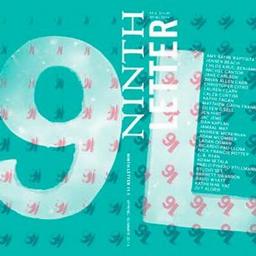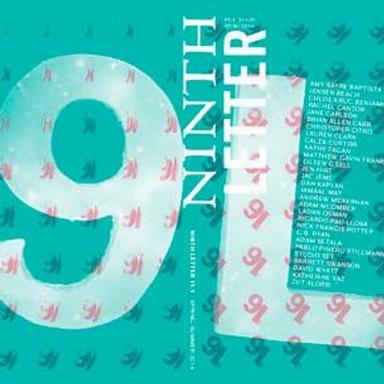Can you tell us a bit about how Ninth Letter started?
Jodee Stanley and other creative writing faculty members at the University of Illinois, Urbana-Champaign published the first issue of Ninth Letter in the summer of 2004, two years after the creation of the university’s MFA in Creative Writing program. Jodee envisioned Ninth Letter as an answer to the homogenous landscape of literary publishing leading up to the early aughts.
In the Editor’s Note in Ninth Letter’s inaugural issue, Jodee wrote “What literary writing is, in America, at least, often seems to be defined by a narrow script that does not allow for much risk-taking…” She wanted to give writers a place to publish their risks (and get paid for it!). Jodee also asks of the publishing world: “… if literary magazines have a collective purpose isn’t it to push toward discomfort—to continually search for the unknown, to find new ways of exploring the human condition, to take into account the constant growing and changing world?” To that end, it was also important to Stanley to show the literary publishing industry that great art and literature can, and does, exist in the Midwest. Mix all of that together and add an “I” and you get Ninth Letter. Fun fact: The magazine was almost call “Flatlands” as an homage to the landscape of the Midwest.
What is your vibe/aesthetic/vision?
My favorite thing about Ninth Letter, first as a reader, then an assistant editor, and now as editor, is that the vision for the magazine hasn’t changed much since its inception. Assistant Editor Chris Maier wrote in the first issue “Ninth Letter … rejects the notion that literature is an isolated mode of expression… We recognize and seek the intersection of literature with various fields of creative and intellectual life…We view the magazine as an organic work of art: the overall interaction among the components is as important as the discreet projects within the content.”
This remains true—we still think about how individual pieces come together to create an art object. We are excited by poems, stories, and essays that incorporate visual arts, journalism, science, history, cultural studies, popular culture; the work that demonstrates how anything can become literature in the hands of a skilled writer. We are looking for the work that takes big risks and leads readers to a kind of emotional or intellectual meaning.
What does your editorial process look like for new pieces coming in?
Ninth Letter is a faculty- and student-run literary magazine, so our editorial structures match that.
Ninth Letter’s print edition is run by the students and professors in the MFA program. Section Editors are professors of creative writing at the University of Illinois, Urbana-Champaign. Assistant Editors and Readers consist of MFA candidates and other faculty at the university. Every submission is reviewed by 2-3 different readers. A submission must receive two “yes” votes before it goes to the editorial table, where the entire genre (fiction, poetry, CNF) team will meet with the Section Editors to discuss the piece and vote on publication. Final selections are made by the faculty Section Editors and the Editor.
Ninth Letter Online (web edition) is run by undergraduate creative writing students, and Specialized Faculty members in the Creative Writing department, who serve as the Web Editors. The editorial process for the web edition is similar to the print edition, but each submission is read by more than 2-3 students, and the Web Editors make the final selections.
Are your issues themed? If so, how does that theme get decided? What are your guidelines or suggestions for how to approach the theme? What is your forthcoming theme?
Ninth Letter Online publishes two themed issues per year in the winter and the summer, but our print editions are not themed. Our web editors collaborate with the undergraduate web staff to choose a theme that is relevant, unique, and inclusive to a diverse range of experiences and demographics, and able to be interpreted in multiple ways. We have not yet decided on the next theme for the web edition but stay tuned to our social media for updates!
Can you speak about the Ninth Letter Literary Awards? What does that selection process look like?
The Literary Awards Contest is held annually and judged by writers outside the university. All submissions remain anonymous until we announce a winner. Every submission is read by two-three MFA candidates. Submissions that received a positive vote from both readers are then read by our senior editorial team and narrowed to 10-15 semifinalists. The semifinalists’ work is then forwarded to the appropriate judge for final selection. Winners receive $1000 and publication in the Fall/Winter issue of Ninth Letter. Winners are usually announced in late summer or early fall.
As the editor, what type of work immediately draws you in? What do you look for in a piece of fiction? Poetry?
This is such a tough question! My ideal submission would be one that surprises me, makes me feel A Strong Emotion, and compels me to re-read. When I encounter work as an editor, I try to turn off my preferences so I can assess each piece on its own merit, not in comparison to my personal aesthetics. I am drawn more to work by writers (in any genre) with strong, unique voices than “perfect” work, and I love experimentation in all its forms, so I’m partial to the passion projects that might not find a home elsewhere.
With such a massive literary community (and having to fight with algorithms), what is Ninth Letter doing differently? Or what do you plan to do differently as you continue to grow?
This is a great question, and I look forward to reading other Chill Subs interviews so I can see the answers of others! We are lucky to have a solid readership, fan base, and Twitter following thanks to Jodee Stanley’s years of work and promotion, so we don’t have to fight the algorithms for submissions. In the future, we hope to expand our online and social media presence so we can grow our readership and our subscriptions. I guess I should start learning SEO?
Are you a writer? If so, what are you working on?
I am a writer—thanks for asking! I’m currently working on my poetry manuscript, Object, which focuses on the intersection of women’s sexuality, the Christian church, and reproductive legislation in the American South.
Can you speak a little about your role as graphic designer? What inspires you as an artist that you bring into your role at Ninth Letter?
Ninth Letter is well-known for its attention to art and design, so it is definitely a lot of pressure to design an issue. I enjoy browsing sites like Behance and Dribbble to see what professional designers are creating as research. I draw inspiration from, as cliché as it is, cool stuff I see. It’s a lot like the advice we get as writers: to observe everything and to collect those observations. I have hundreds of pictures of packaging, advertisements, and signage with good design on my phone that I reference. I get a lot of ideas from pretty banal things—like the manhole covers in Champaign have this really cool, mid-century-esque hexagonal pattern that will be making an appearance in a future issue.
While I love designing and creating art, one of the exciting things about the design of many past issues is that it was done by a team of artists. To get closer to that original intention, we are planning to open for art submissions in the future, but we don’t have all the details ironed out yet.
View Ninth Letter on Chill Subs

